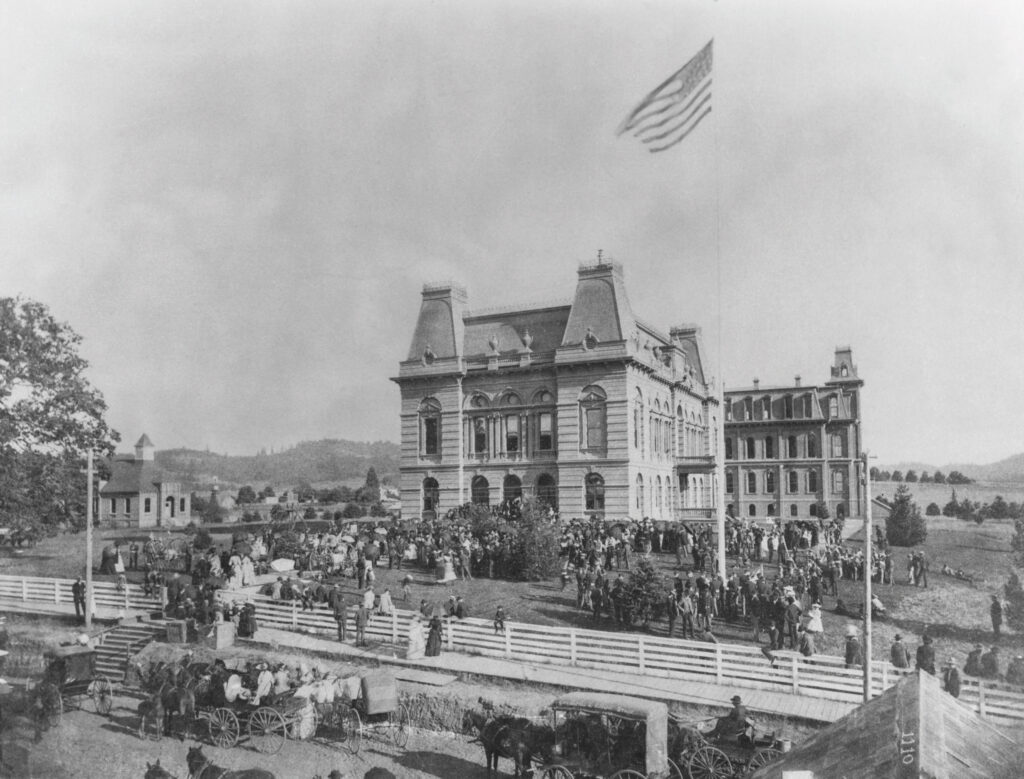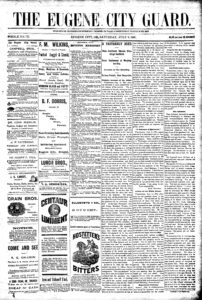UO’s first graduating class: five students

1877-1887
ALEXANDER BROS.,
Publishers and Proprietors
OFFICE – In Underwood’s Brick Building
over Crain’s Jewelry Store
That’s what was printed in the upper left corner of the May 12, 1877, edition of The Eugene City Guard.
William and Frank Alexander would own The Guard for just 18 months, only two months more than their father. Their youngest brother, George, would become a reporter at The Oregonian and then settle in Lebanon, where he ran the Lebanon Express until 1936, according to his 1946 obituary in the Albany Democrat-Herald.

After five different managements and eight publishers in just 11 years, the Alexanders sold to another set of brothers, Ira and John Campbell, in November 1878, and that turned out to be a very good thing for The Eugene City Guard.
Ira Campbell, like William Thompson, was just 22 in 1878, but would serve as publisher for 26 years, until his death from a stroke in 1904 at age 48.
The Campbells gave the Guard direction and stability, according to Warren Price’s book on the first 100 years of Guard history.
They toned down the paper’s “vituperative language so frequently used during Civil War and Reconstruction,” expanded content, took notice of the local scene and instituted sound management policies.
“Upon building up a live local paper, our best energies will be called forth … we shall be found always advocating the interests of Lane County, and of Eugene City in particular,” they wrote upon taking over.
Ira Campbell gave the Guard character, Price wrote.
He was born and raised in Lane County and he “likely came by his Democratic Party sympathies through his father, Andrew Jackson Campbell,” who lived at Long Tom (near present-day Fern Ridge) in Lane County, where Ira was born.
His father moved to Eugene City when Ira was a boy and operated a tool shed off the north side of Ninth Avenue (now Broadway), across from Harrison Kincaid’s Oregon State Journal, which Ira often visited, piquing his interest in newspapers.
As Eugene City’s population inched back over 1,000 (1,117 in 1880 census) for the first time since before the Civil War, on its way to almost 3,000 citizens by 1890, Ira Campbell is credited with doing several things that improved the Guard before making it a daily paper in 1891:
He increased the size of the paper; gradually altered headline display and expanded news coverage, making sports and crime news more prominent; and in 1887 he installed a power press run by a water motor.
Besides having to compete against Kincaid’s Oregon State Journal, another new newspaper emerged in Eugene City in 1884: The Eugene City Register.
For the next 25 years, Eugene would be a three-newspaper town, although the Oregon State Journal would remain a weekly throughout its 45-year history, while both the Guard and the Register would become dailies in the 1890s.
Silas Yoran was 49 when he launched the Register. He arrived in Eugene in 1883 from Iowa, where he had been a farmer and a merchant and served in the Iowa Legislature. He and partner John Hodson got the newspaper up and running. After Hodson moved to Portland in 1888, Yoran’s son, William, became a co-owner with his father.
In 1891, Silas Yoran would turn the paper over to William and another son, George Yoran, after leaving to run a shoe store in Eugene. He also become vice president of Eugene National Bank.
While the Guard was always a backer of the Democratic Party, both the Oregon State Journal and the Register were Republican newspapers, according to Price.
Circulation for all three weekly newspapers in the 1880s was under 1,000, with the Guard having 960 paid subscribers in 1885, the State Journal 800, and the Register 660, according to Price.
The Eugene City Guard was the first to go over 1,000 in circulation, in 1887, according to numbers provided by George Rowell’s American Newspaper Directory, a precursor to the Audit Bureau of Circulations.
The Guard had a circulation advantage of being the only Democratic newspaper in town, competing against two Republican-owned papers, Price wrote.
Price describes the Register as “a dull paper that was profitable early, mostly because it was also a printing shop,” but says it didn’t show any editorial enterprise until the late 1890s.
During this second decade of Eugene City Guard existence, the University of Oregon graduated its first class, a total of five students, in 1878, and survived possible closure when prominent newspaperman and businessman Henry Villard came to the rescue.
The Bavarian-born Villard, owner of The New York Evening Post as well as the weekly magazine The Nation, moved to Oregon in the 1870s and also bought the O&C Railroad. He gave the UO $7,000 in 1881 to pay off its debt and keep the doors open, and then donated $50,000 to the university in 1883 on the condition that the state would create a tax levy to help maintain it, according to various news accounts of the day.
The UO built and named its second building, Villard Hall, which was completed in 1886, after Villard.
Other major happenings during this time included: Construction of the first Eugene City Hall on the northeast corner of Eighth Avenue and Park Street in 1883; the first Lane County Fair, Sept. 25-27, 1884. (Tickets were 25 cents); and the first electric lights in Eugene in 1887.
Mark Baker, who researched and wrote the stories for this special section, is a former Register-Guard reporter and a member of the third generation of the Baker family.

Mark Baker has been a journalist for the past 25 years. He’s currently the sports editor at The Jackson Hole News & Guide in Jackson, Wyo.
